Jalapeño-Cheddar Sourdough Bread
This is my take on the oh, so popular jalapeño-cheddar bread that sourdough bakers have been raving about. Just a couple of simple seasonings makes the already-great original even better.
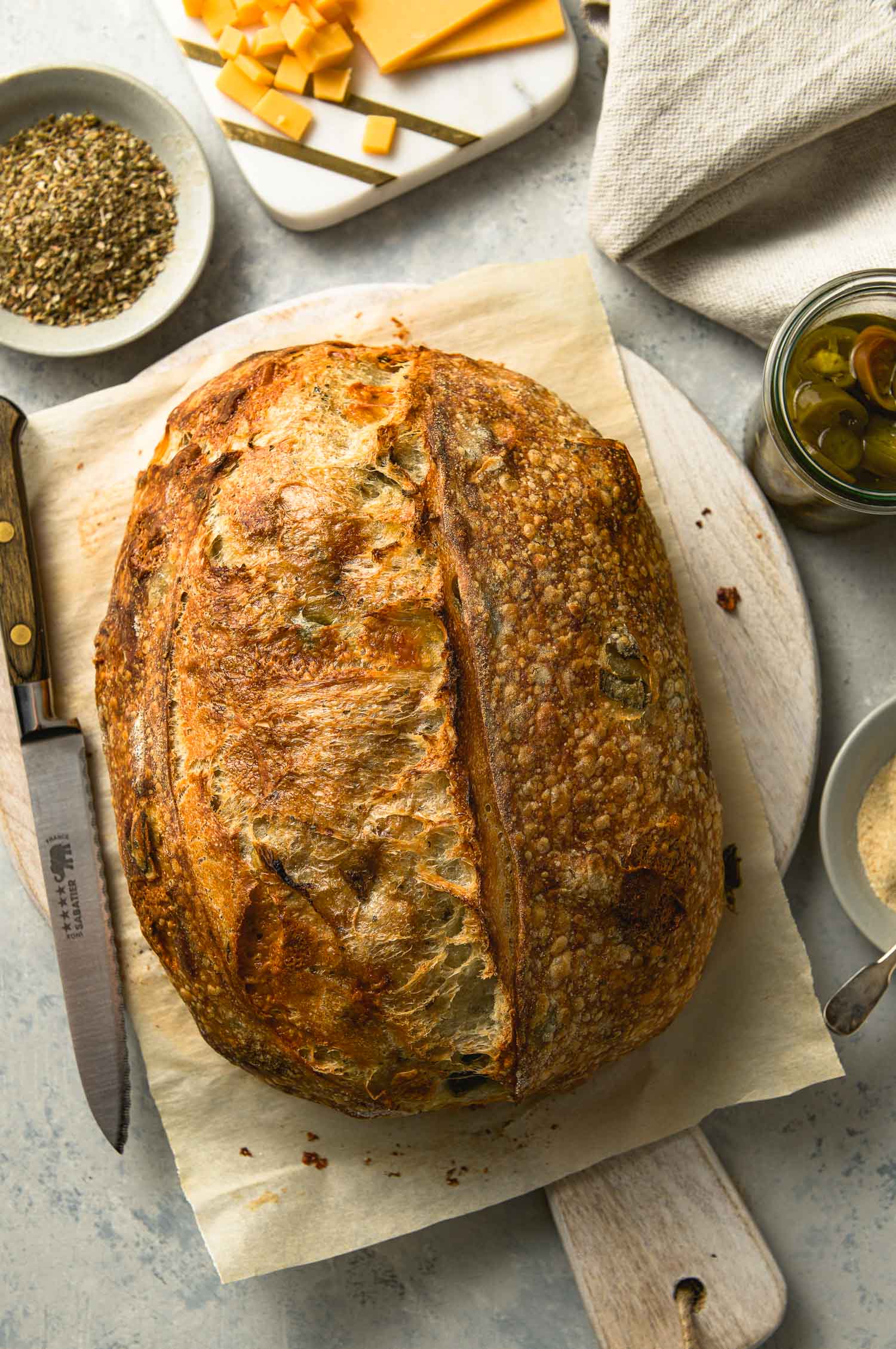
If the sourdough baking forums I have followed for years can be a reliable meter of baking trends then jalapeño-cheddar bread developed a cult following after the pandemic started last year. For the lucky who managed to stockpile flour, this flavor combination became the go-to for a savory take on classic sourdough bread.
During county stay-at-home orders I baked three to four sourdough loaves a week so I was a prime candidate for jumping on the jalapeño-cheddar bandwagon…but I resisted.
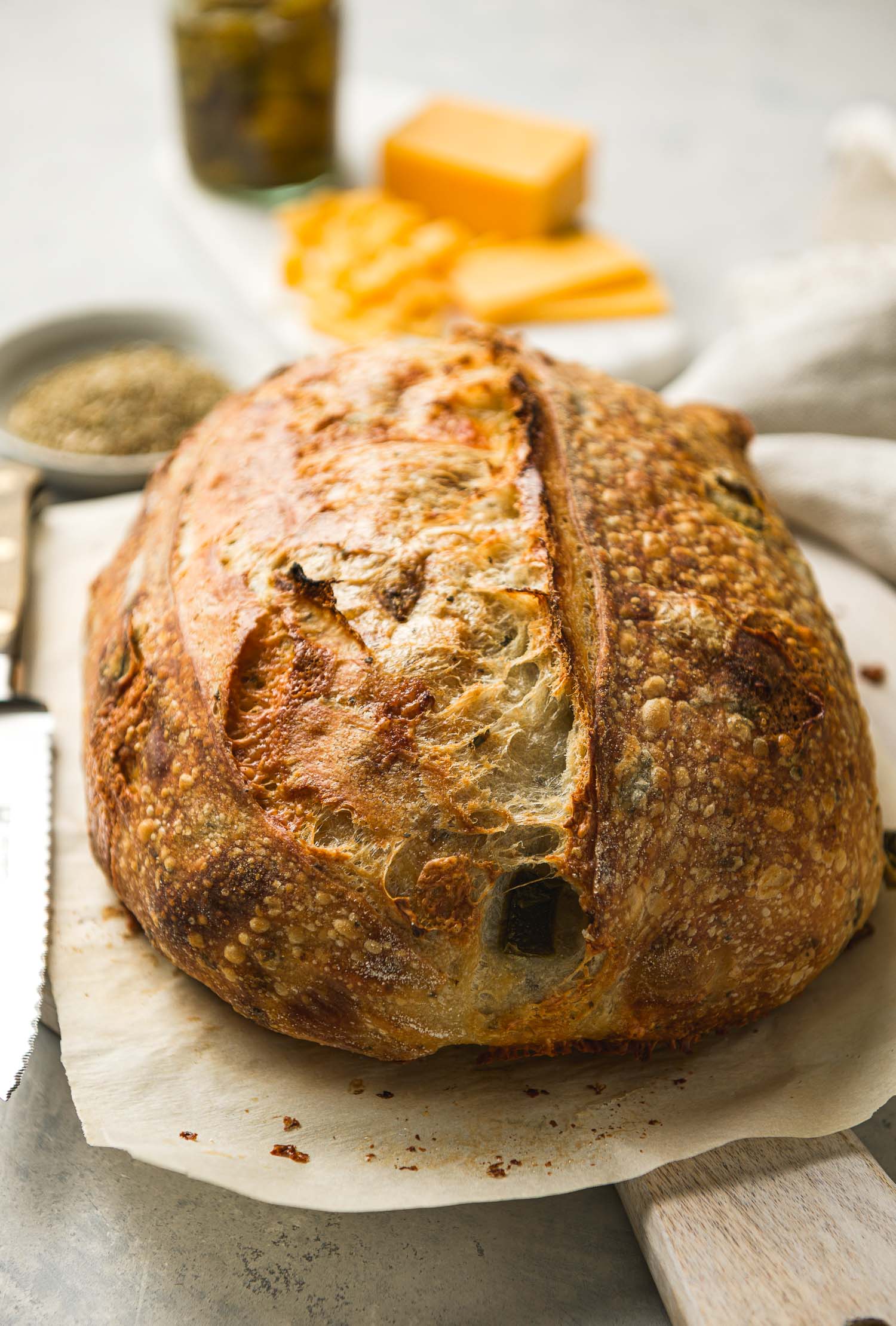
I just couldn’t get excited about it though I’m a fan of both ingredients. Instead, I churned out olive loaves, bread studded with figs and pancetta and some sweet bakes using chocolate and various dried fruit.
Then one day, my dear friend Georganne (who also happens to be my sourdough partner in crime) told me that I absolutely must try the jalapeño-cheddar combination. She raved about it–and understanding that she has a palate that will always be more discerning than mine, if she said something was good then I had no choice but to give this combination a try, too.
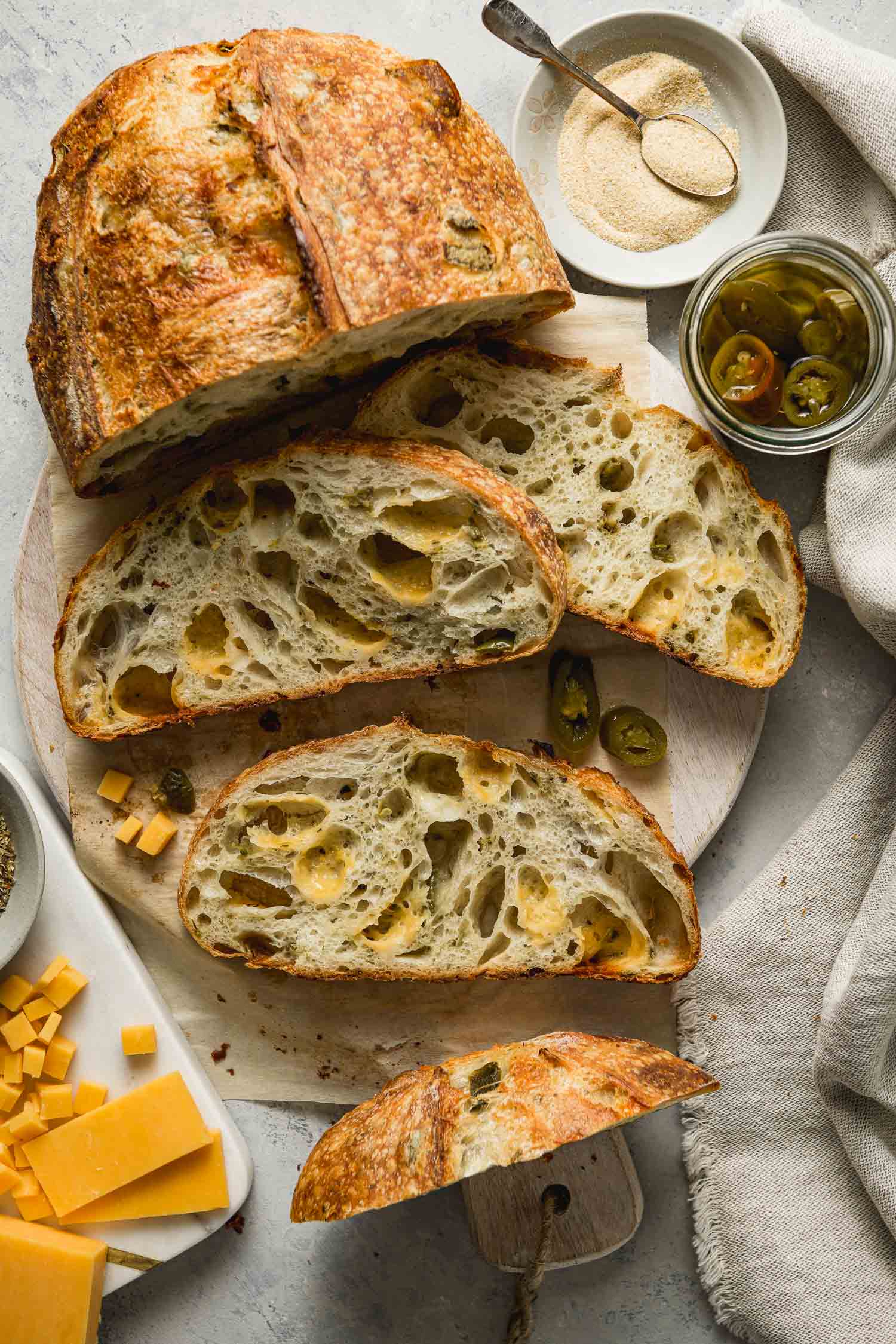
Unsurprisingly, Georganne was spot on. A slice of sourdough bread studded with jalapeño peppers and cheddar is a heavenly combination and though it’s perfect on its own, it’s taken my standard ham and cheese sandwich to new heights. My husband has been enjoying it pan con tomate style, a toasted slice rubbed with garlic then dipped in a grated tomato/olive oil/oregano mixture.
Sliced raw jalapeños or the pickled variety from a jar work well in this bread but like Georganne, I prefer the latter (I love pickled everything).
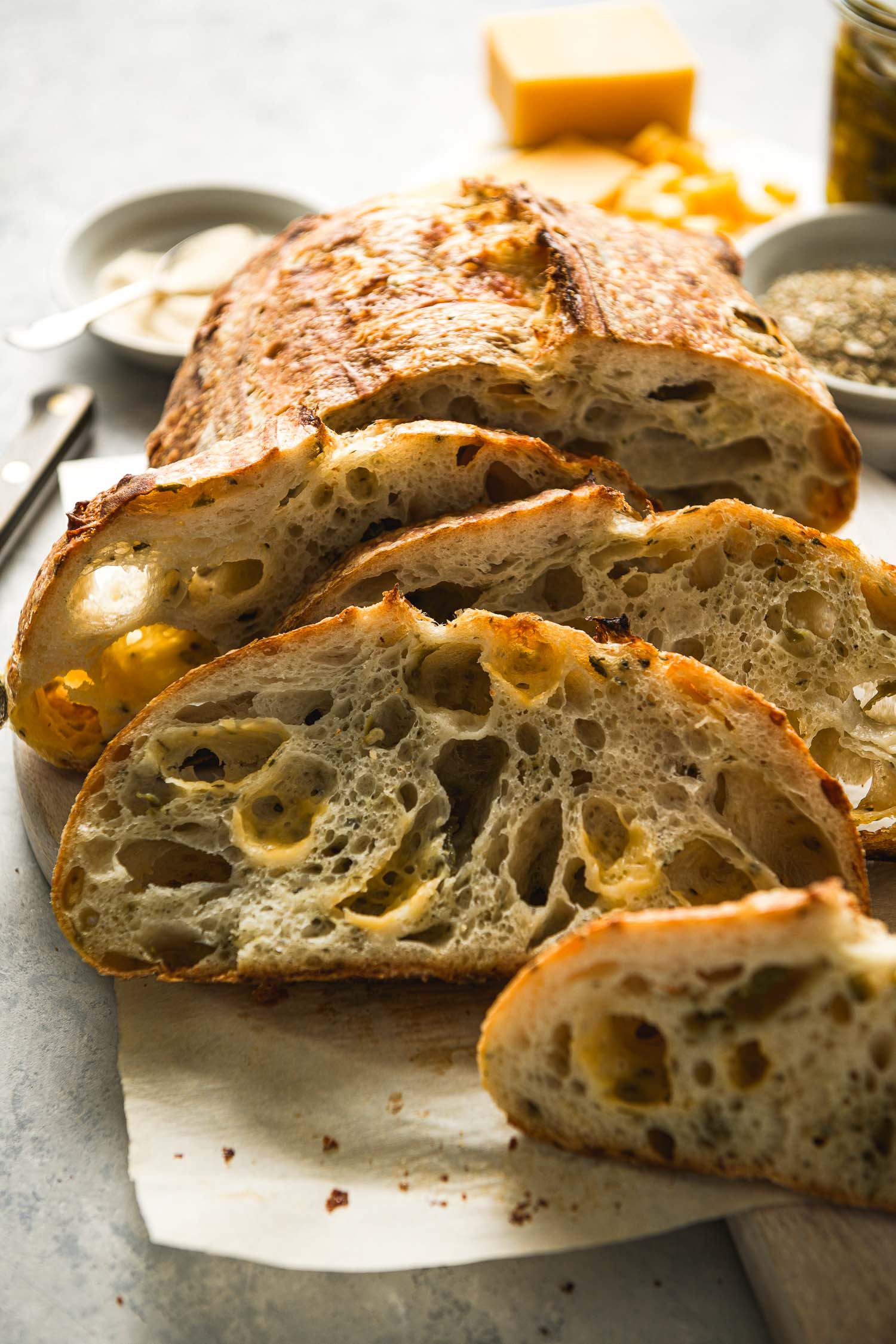
My Variation on Jalapeño-Cheddar Sourdough Bread
Since baking my first loaf with these add-ins last summer this has become one of my weekly go-tos for bread and by sheer chance I came up with a small tweak that made the original idea just a little better.
On a whim one day I added dried oregano and onion powder while incorporating the add-ins. I had the jars sitting on the counter for the aforementioned pan con tomate and decided to just throw them into the mix, too. That loaf turned out so flavorful that I’ve prepared my savory bread this way since.
The simple seasonings amplify the savory goodness of the already punchy pickled peppers and mildly salty cheese tucked into big pockets all along the loaf. And the fragrance…you can’t rush good bread but it’s tempting to cut the baking time short when the kitchen starts to smell herby and cheesy–not unlike pizza but without the tomato or even meat but you get the idea.
Actually, I had not planned on sharing this particular recipe since I didn’t think the world needed another but here we are. I’ve been a little quiet on this blog but I’ve continued to share my bakes on my Instagram stories and this loaf would always garner requests for the recipe after people who visited the blog looking for it couldn’t find it. It’s also a nice way to ease back into blogging after my months-long absence now that things have settled down around here and I’ve had a chance to dust off the camera and spend time here again. Several months of shuttling between here and Idaho to finish furnishing our new place required pressing the pause button on blogging but the baking never stopped. Also, L&A turns eleven (!!) in a few days so I’ve been trying to line up new recipes to share. In the meantime, if you’ve been looking for something new to add to your sourdough rotation this recipe might just be the one to try.
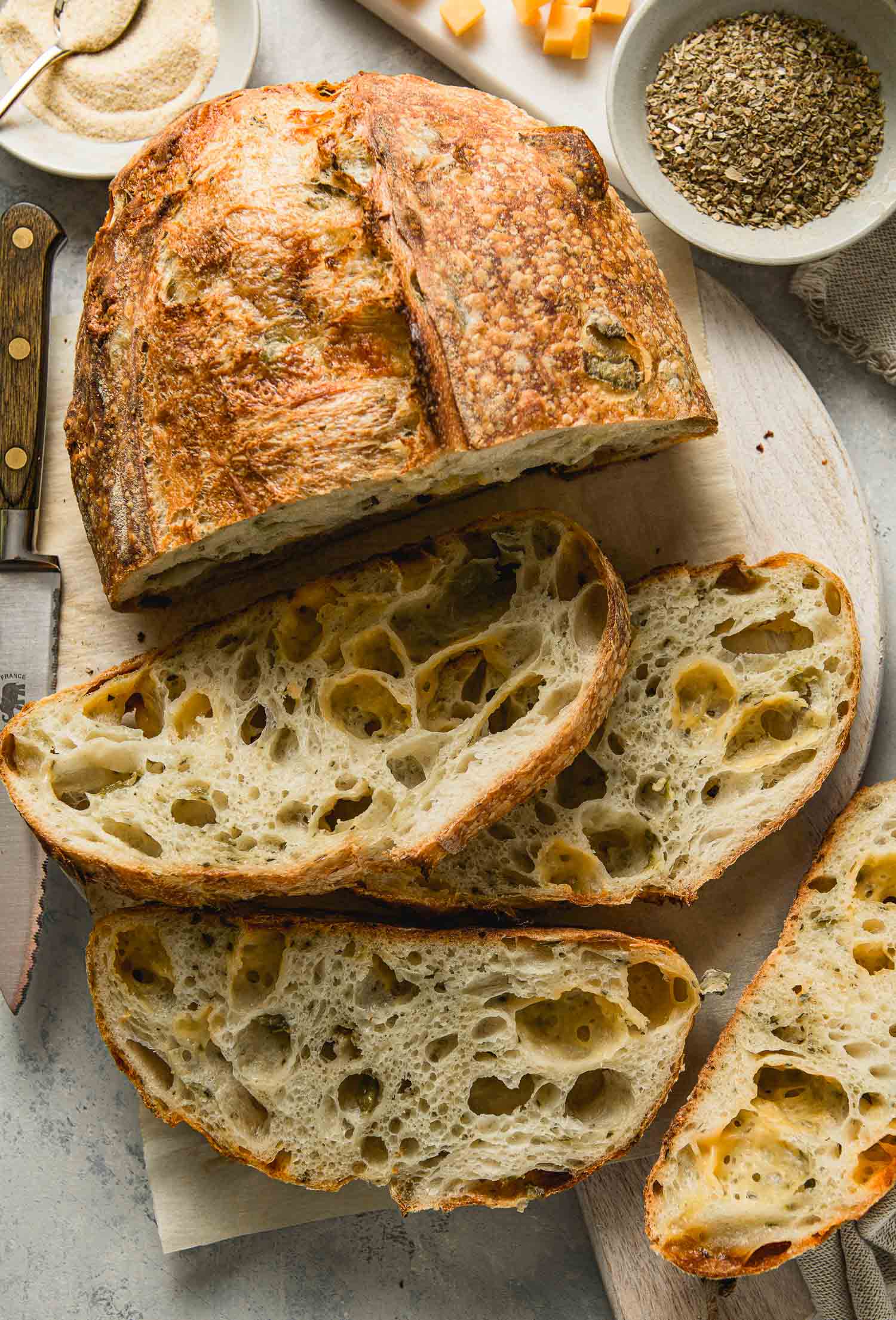
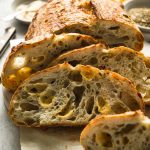
Jalapeño-Cheddar Sourdough Bread
It's hard to imagine how to make the original Jalapeño-cheddar bread even better but I urge you to give my simple additions a try. You won't be sorry.
Ingredients
- 330 grams bread flour
- 260 grams water
- 70 grams active sourdough starter (100% hydration)
- 6 grams kosher salt
Add-Ins (Feel free to use more)
- 60 grams sharp cheddar, diced
- 55 grams pickled jalapeño peppers, chopped
- 3/4 – 1 teaspoon onion powder (~3 grams)
- 1 1/2 – 2 teaspoons dried oregano (~2 grams)
Instructions
Day 1
-
Autolyse: Combine the flour and water in a bowl and mix well with your hand or a spatula. (Your dough might look rough and lumpy.) Cover with a towel or plastic wrap and let sit between thirty minutes to two hours.
-
Add starter: After autolyse (the dough will look smoother), add the sourdough starter and make sure to combine well by pressing it into the dough with your fingers and using the Rubaud method to properly incorporate. It helps to dip your hand in water before handling the dough. Cover and let sit for thirty minutes. (See Notes for link to Rubaud method). Bulk fermentation time starts now.
-
Add salt: Sprinkle the salt over the dough and using the same mixing method as described above for the starter. Cover and let rest thirty minutes.
-
Stretch and Fold 1 and 2: Take one portion of the dough, pull it up to the point of resistance and fold over itself. Repeat this until you've gone around the dough one full rotation. Follow this stretch and fold motion for two or three rotations then cover and let rest for thirty minutes. This is SF1. After thirty minutes repeat the stretch and fold process and wait another thirty minutes. (The dough will be extensible with the first couple of stretches/pulls but it will begin to pull back/resist with each stretch. This is to be expected.)
-
Lamination/Add-Ins: Spritz your work surface with a little water then turn the dough out on the counter. What was the surface of the dough in the bowl will now be the bottom. With wet hands gently pull the dough into a large rectangle. Don't force it, it might be elastic and want to pull back but it will eventually stretch without tearing. Sprinkle most of the onion powder and oregano over the entire surface of the dough. Then scatter most of the cubed cheddar and chopped jalapeño all over the dough. Take one top and bottom corner of the dough and fold 2/3 of the way over. Sprinkle the remaining seasonings and add-ins over this new fold. Take the other top and bottom corner and fold over the first fold. Now take the bottom of the dough and fold over in thirds or fourths. Transfer to a glass baking dish spritzed with water seam side down. Cover with plastic wrap and let rest for 30 minutes.
-
Coil Folds 1 – 4: With wet hands pick up the dough from the center on each side and lift until one portion of the dough separates from the casserole dish and tuck it under the rest of dough. Rotate and repeat on the other side. Doing this twice. Repeat this coil fold session every thirty minutes until you see your dough gaining more structure between folds. Four coil folds were performed for the loaf pictured here but you may only need three depending on how your dough looks.
-
Bulk Fermentation: Bulk fermentation starts the moment you incorporate the sourdough starter into the dough. After the last coil fold allow the dough to finish bulk fermentation until it has grown by at least 50% to nearly double in size. The total time will vary with the temperature of the dough. If the dough is in the mid 70s F, you can expect bulk fermentation to take around 5 1/2 to 6 hours (much shorter with warmer temperatures). But watch your dough and look for signs. Watch for bubbles on top of the dough–it should also look lighter and airier with rounded edges.
-
Shape and Cold Retard: Dust your banneton (round or oval)with rice flour. Turn the dough out on a lightly floured surface. The top of the dough now becomes the bottom. Gently pull the dough to flatten it a little, fold in thirds and roll into a ball. Transfer the dough to the banneton seam side up, pinching the seams together. Cover with a plastic bag and refrigerate overnight.
Day 2: Bake Day (Morning or afternoon)
-
Put your dutch oven with the lid on in your cold oven and preheat to 475ºF. When your oven has reached temperature take your dough out of the refrigerator and flip it over on the counter lined with parchment paper. I like to use a small cutting board for this step (parchment paper between the banneton and the board) to make it easier to flip the dough out. Brush the excess flour from the top of the dough and score. Put on your oven mitts and take your dutch oven out of the oven. Remove the lid and gently lay the dough in the pot using the parchment paper. (You can lightly spritz the dough with water to help with oven spring but it's not necessary.) Cover, return to oven and bake for 20 minutes. Reduce the oven temperature to 450ºF, remove the lid and bake for another 10 minutes. Reduce the temperature again to 425ºF and bake for a final 10 minutes. Cool on a wire rack for at least three hours before slicing.
Recipe Notes
Alternative methods (if you’re a seasoned baker and feel comfortable taking liberties with my instructions.)
- Instead of separating autolyse, adding starter and adding salt in intervals, you can mix the dough (flour, water, starter, salt) all at once if you feel comfortable taking shortcuts. Ultimately, total bulk time will be dependent on the dough/ambient temperature so the key is to watch the dough and how it rises. You can also keep the autolyse separate then add the starter and salt at the same time.
- You can shorten to one stretch and fold before lamination. Flours behave differently so it will depend on how your dough behaves.
- You may only need three coil folds instead of four. Again, watch your dough.
Technique:
- Rubaud method: You can watch the technique here.






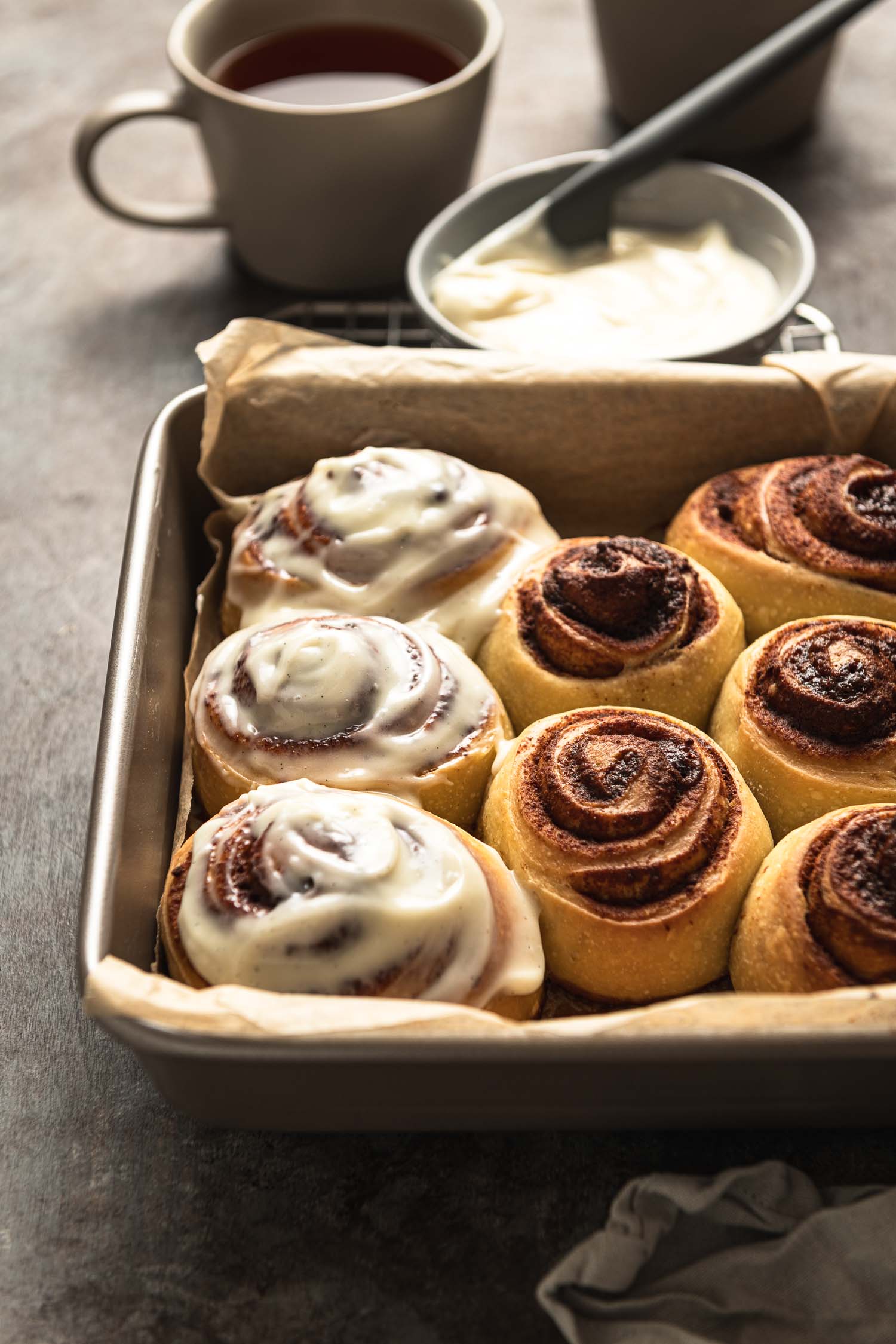
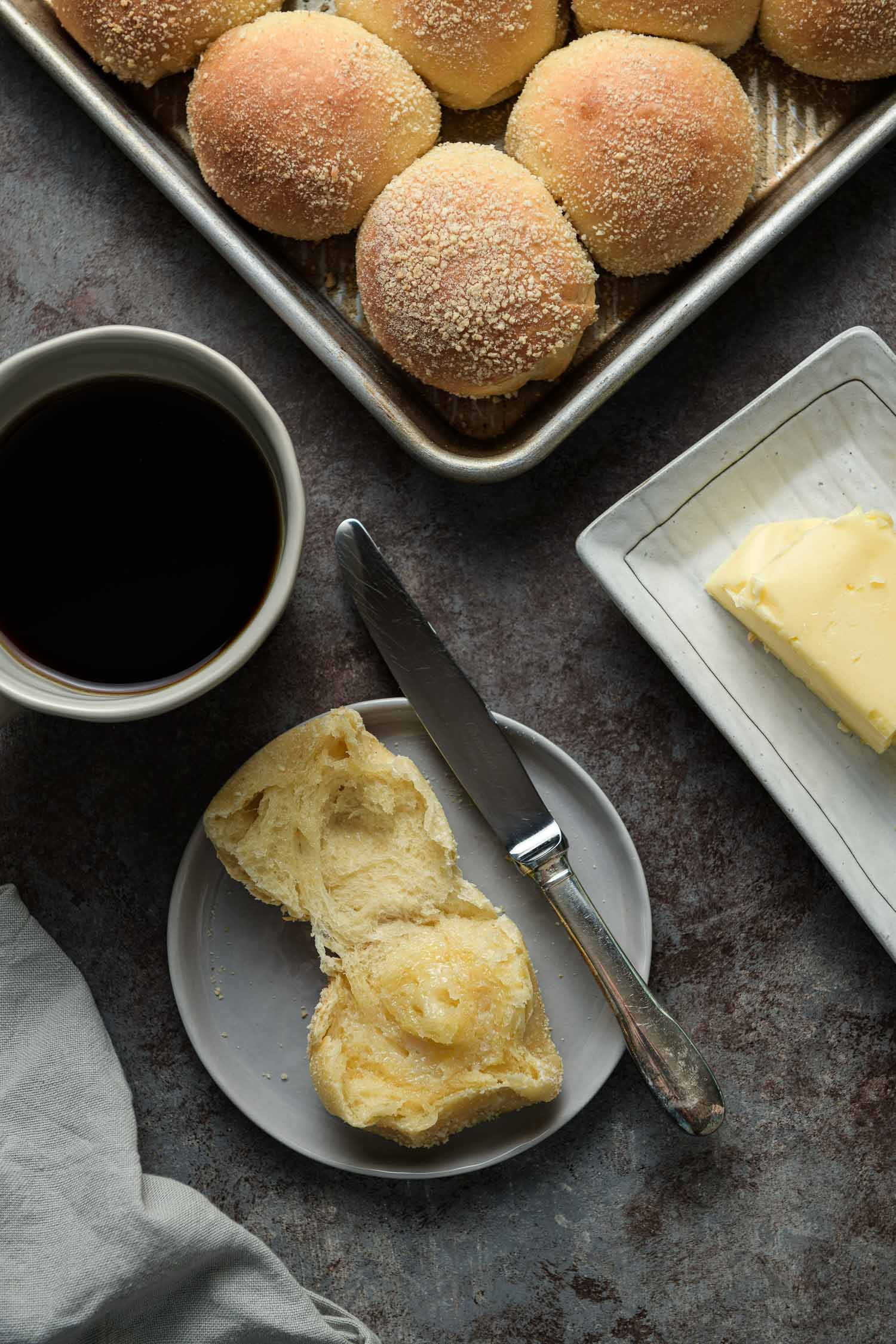
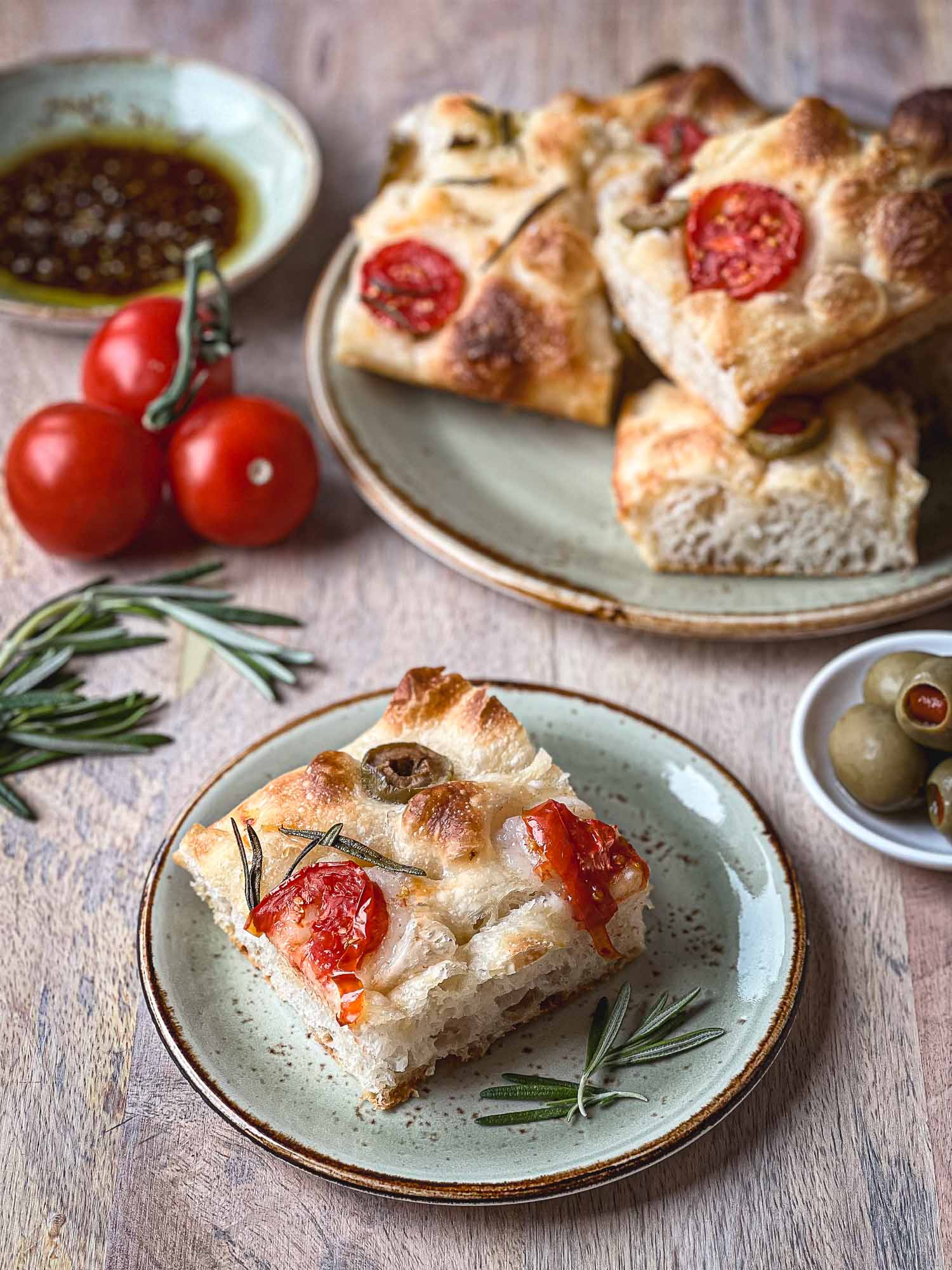

Wow. This is absolutely gorgeous! How good it would be with chili or birria!
What time line would you suggest on this? Typically, I’ve been starting my loaf mixture between 4-6pm, on a standard no fuss SD boule without any add ins. Mix, rest 1hr-4x S&F, overnight counter BF, then fridge at 7am and bake later that night. Here I started this recipe at 1pm with autolyse, mixed the starter around 2:30pm and from there followed the every 30 minutes steps. Around 9pm I put my boule into the banneton and into the fridge. My attempt at this recipe seemed as though it went into the fridge too soon and probably did not proof long enough on the counter. I baked it 8am,. It had very little oven spring. Waiting to check the crumb but I do not expect it will be ideal. Would love to hear what hour you start your mixing as staying up later to wait on this wasn’t an option for this particular- maybe the next one I start in the morning and it’ll have BF’d enough before bedtime.
Hi, LD. Your 1 pm autolyse and refrigerating overnight after bulk is very close to my usual routine. I feed my starter in the morning, autolyse before it reaches peak then proceed from there. Based on the day’s (or the dough’s) temperature I adjust the total bulk fermentation time. Generally, if it’s in the mid-70s (ºF) it will take at least five hours to bulk. How was the crumb?
As an alternative, you can also mix your dough earlier so this would mean feeding your starter in the evening. You can use a low inoculation (ratio of starter to water/flour) and cooler water to slow its activity so it’s ready for you in the morning. Autolyse then mix the starter and salt at the same time. This should get you to an earlier bulk fermentation stop time. Hope this helps–I’m planning to share a post discussing the alternative timelines for sourdough baking. Let me know if you need more help. 🙂
This bread sounds delicious! I’m making it this afternoon and letting it cold retard overnight. There are a couple of techniques that are new to me, coil folds, and Rubaud method, so it’ll be interesting to see how this loaf turns out. Thanks for your post – I enjoy your style of writing and again the details of each of your recipes.
Hi, Mabel. Thank you so much for your very nice compliment! So appreciated! The coil fold and Rubaud methods were new to me, too, and I found they helped to build strength in the dough and to make sure the ingredients (particularly the starter and salt) were incorporated evenly, respectively. They are not absolutely necessary but good techniques to learn and discover what they do to dough. As you bake more bread, you will decide to take your own shortcuts and maybe forego coil folds for strictly stretch and folds and this is okay–I do this. Instead of the Rubaud method, sometimes I will add all the ingredients (flour, water, starter, salt) all at once but make sure I stir in the starter and salt into the water first before adding the flour to ensure more even distribution. It all works. You’ll develop your own method and style. 🙂 I’m planning to share a post that talks about different ways we can be flexible with our bread baking process. 🙂
Just a follow up to my previous comment – I baked the bread early this morning on a flat baking pan lined with parchment. It is delicious; my husband loved the varied flavors in it. It didn’t have as much oven spring as I would have like to have seen and has nice openings in the crumb. I have a question about the bulk fermentation after the coil folds, should I have let the dough continue to ferment at room temperature until nearly double before shaping and cold retard? I placed the shaped dough in the refrigerator after 4 hours of bulk fermentation at room temperature which usually is between 66-68 degrees F. It was interesting to use the techniques you describe to mix in the additions and to strengthen the dough. They are much gentler than regular kneading. Thanks again for all your lovely recipes!
Mabel, I’m so glad you and your husband enjoyed this recipe and thanks so much for the feedback. So what I’m finding with bulk fermentation time is that cooler temperatures that you described will require a longer bulk time (from the time you add the starter to the dough). If you use room temperature water your dough temperature should match your room temperature pretty closely. Sometimes I use an instant read thermometer to get the temperature of the dough itself and on especially cold days I will use warmer water to bring the dough temperature up to mid 70s for a bulk fermentation time around five hours to five and a half hours (with 20% starter and strong flour). Bulk would be complete once it’s doubled or nearly doubled.
A tip for learning to “read” your dough for completion of fermentation: I take the temperature of the dough at different stages–after mixing, after stretch and folds and coil folds. This allows me five to six readings. I take the average dough temperature from these readings and assess total bulk fermentation accordingly. I hope this helps. Happy to clarify. (Also, the add-ins can sometimes weigh the dough down so you won’t necessarily get a huge open crumb). 🙂
This bread is phenomenal, I have had nothing but compliments on it! I’ll be working the ratios a little bit as a project to make the loaves a little bigger! Thanks so much for sharing!
Becca, this is wonderful to hear! So glad this recipe has worked for you–thanks so much for the feedback!
I am making this recipe now. Can you bake it after a proof in my banneton without a cold retard? I make a double batch?
Hi, Nancy. Yes, you can. I hope this recipe worked out for you. Cold retardation is not absolutely necessary. It enhances flavor but you can skip it.